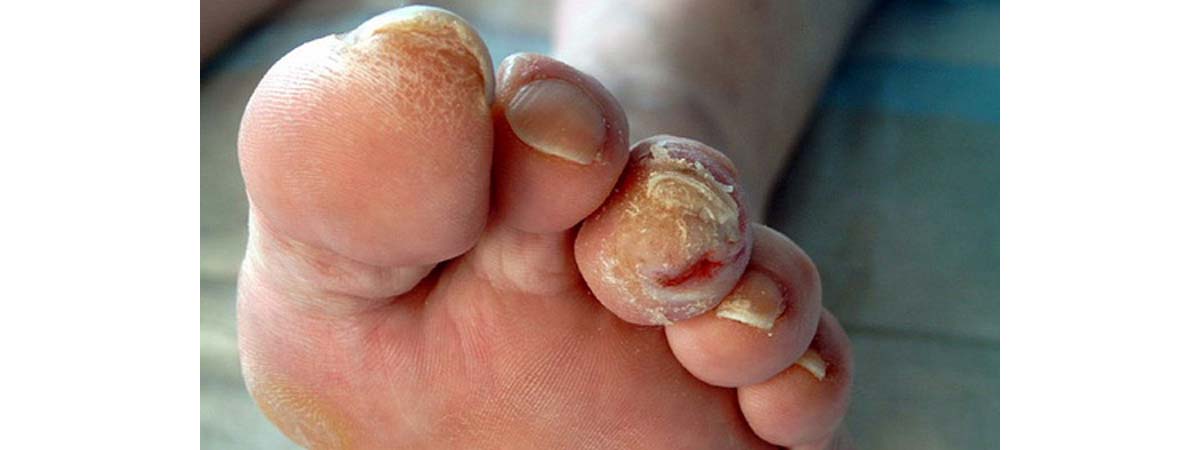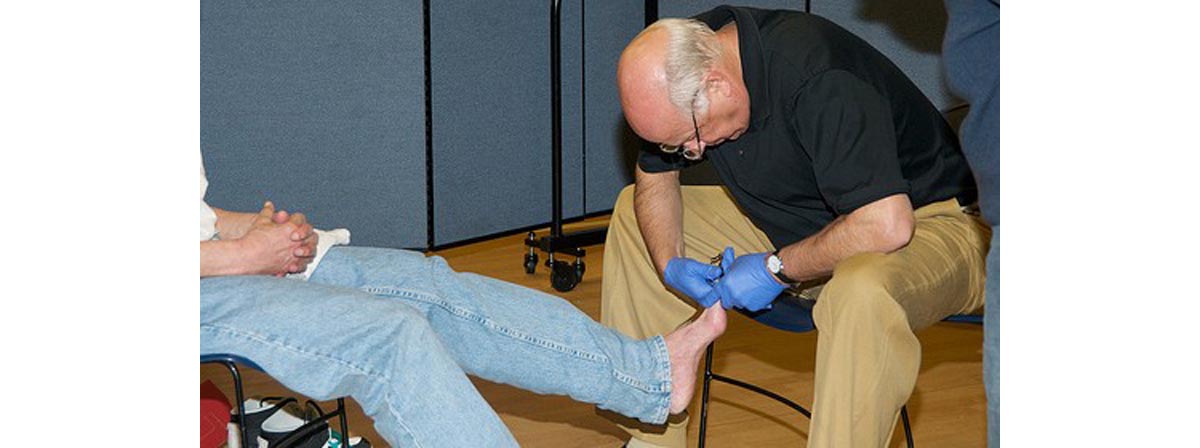There are currently are 415 million people in the world with diabetes and it is thought that by 2040 this number will reach more than half a billion. In fact, the prevalence of diabetes is quite shocking — over nine percent of the global population suffers from this condition. Ninety percent of these people have Type 2 diabetes, which is associated with obesity, poor diet and lack of exercise.

Also people who have lost limbs through diabetes have a two to four-fold increased chance of dying prematurely, compared to people without diabetes.
Nerve and blood vessel disease, coupled with defects in the immune system and inadequate care form a terrible cocktail, frequently leading to serious foot problems.
Nerve disease and injury
Something that’s not well-known is that diabetes leads to nerve damage, causing a condition called peripheral neuropathy. This simply means nerve disease affecting the nerves in the extremities – most notably in the feet and legs.
At first there may just be altered or impaired sensation, but this quickly progresses to numbness.
The issue with neuropathy is that people cannot feel when damage has occurred to their feet. For example they may not be able to feel a stone in their shoe, even when it pierces the skin and causes a wound. They will also tend to wear shoes which are too small, because they cannot feel the pressure and correctly-fitting shoes will feel loose to them.
Impaired blood supply and wound healing
Another problem is that the supply of blood to the feet is reduced in patients who are living with diabetes. The significance is that if there is a wound to the foot, there is not enough blood containing nutrients and white cells to heal and fight infection. Therefore, compared with a non-diabetic person, wounds in diabetic people are much more difficult and take longer to heal, and they are also more likely to become infected. As sensation loss may be present, patients may not even notice this immediately.
This is where the tissues die because they have not enough blood – which is also referred to as ischemia. Having a wound increases the need for blood and can ‘tip the balance’ into ischemia.
Immune defects and inability to fight infection
High blood sugar levels, often seen in diabetes patients, impair the ability of immune (white) cells to fight infection. This is why diabetic foot wounds take longer to heal and can have much more serious consequences than for non-diabetic individuals.
How do the consequences of diabetes lead to amputation?
Generally the problems all start with a wound to the foot. This injury may have been caused by an accident such as the example of a man who fell asleep with his feet on a radiator. Because of numbness he couldn't feel the heat of the radiator, and poor tissue quality led to a burned big toe. The resultant wound would not heal because insufficient blood reached the toe. The increased demand of the damaged toe for blood made it ischemic and the tissues of his big toe died.

There are two options in these circumstances. One is to amputate the toe, as having a long-standing wound is a burden to the person’s overall health, and the toe will never heal once it has become gangrenous. But with limited blood supply to the area, there is a danger that the new wound – caused by the surgery – won’t heal either.
The other option is to let nature take its course.
The advantage of this is that the tissues are ‘sealed’ off as the toe slowly comes away, so that there is no wound left to heal.
Corns and callus can be the culprits
When our feet are rubbed by poorly fitting shoes they produce hard skin known as calluses or corns over the area, to protect the foot. In a non-diabetic person the worst that can happen is that the corns are painful and need to be removed (cut away) by a podiatrist. But often when people with diabetes have their corns cut away, a deep wound or ulcer is revealed below the corn. This is because the pressure has been so great that the underlying tissues dissolve. This might sound extreme but loss of feeling means people are unaware of the damage and the tissues are particularly fragile.
This is particularly serious as such deep ulcers often become infected, and the bacteria can easily spread to infect the bone (called osteomyelitis).
One thing can lead to another
As mentioned, the lack of blood supply and impaired immune system may prevent a wound, such as an ulcer, from healing. The wound may increase in size or may cause death of the tissue. Either of these events may bring about the need for amputation of part of the foot – in an attempt to get back to healthy tissue.
Often the first amputation is done to only remove a part of the foot, then below the knee, then sometimes the whole leg.
This is the reason that people who have had amputations as a result of diabetes have reduced life expectancy.
Prevention is best
The people who experience the worst complications are those whose diabetes is poorly controlled. This means not managing to maintain blood sugar levels within the recommended range. So good lifestyle management – good diet and exercise – coupled with adherence to medication, will help to prevent serious foot problems.
Also, following commonly available foot-care advice and regularly seeing a podiatrist will help to keep feet in good condition, and allow for early treatment of any problems before they become serious.
- www.itb-thioctacid.ru/files/pdf/1996_boyko.pdf
- Edmonds ME and Foster AVM. Managing the Diabetic Foot. Published by Blackwell Sciences Ltd, Oxford, UK
- Neale’s Disorders of the Foot. 8th Edition. Published by Churchill Livingstone, Edinburgh, UK
- Photo courtesy of Pflegewiki-User ApoPfleger by Wikimedia Commons : commons.wikimedia.org/wiki/File:Offene_Wunde_bei_einem_diabetischen_Fu%C3%9Fsyndrom.jpg
- Photo courtesy of Christiana Care by Flickr : www.flickr.com/photos/christianacare/6466239237/
- www.diabetes.co.uk/diabetes-prevalence.html

